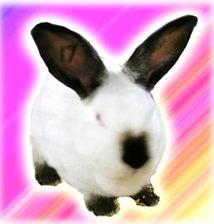Himalayan Rabbit Color Genetics
Last Updated on September 29, 2017 by The Rabbit Smarties Team
What’s black on both ends and white in the middle? No, it’s not an oreo, because it walks. No, it’s not a belted cow, because it has ruby red eyes. It must be a Himalayan Bunny!
In rabbits, “Himalayan” is the name of both a color and a breed that sports that color. The Himalayan breed is a pretty cool study, too, but this article’s concern is with the variety.
CLOSE TO COLORLESS
The Himalayan color is pure white with dark “points”; that is, the nose, ears, feet, and tail are colored while the rest of the bunny is white. This is caused by a gene that is commonly called the “Himalayan gene”, symbolized by the letters ch. The group of “C” genes in rabbits controls the amount and placement of the color. The “Full Color” gene, symbolized by a capital C, produces varieties like chestnut, black, blue, chocolate, and otter. The lowest and weakest “C” gene is the Ruby-Eyed White gene, symbolized by a lowercase c. The REW gene removes all color from the fur and eyes.
Himalayan, or “ch”, is just one step above REW—most of the color is gone, but it lingers on the rabbit’s extremities.
FUSSY ABOUT THE WEATHER
The curiosity of the Himalayan markings is that they are heat sensitive. A Himalayan that grew up in a cold climate will have darker points than one raised in a hot climate. In fact, some Californian or Himalayan breeders that live in southern regions actually have a “chiller room” where they keep the temperature low to keep their rabbits’ points dark. The flip side is that in the northern climates, rabbits can develop smut or spots on the body over the winter, which is a disqualification. This often happens when the rabbit lies against a cold metal divider or feeder overnight. These spots, called “smut” may molt out the next summer, or the rabbit may wear it the rest of its life. Darrel Howe, a leading Californian breeder, told me that if you want the best, most even point color, keep a climate controlled rabbitry at about 45 to 65 degrees Fahrenheit.

Himalayans are born pure white and the color starts to show up on the points between two and three weeks of age. My theory is that this late start to the color is due to the hot nestbox, and another breeder added that perhaps the extremities show color because they are the farthest away from the internal heat source of the rabbit. Baby Himalayans that get cold because they were born on the wire or in a scanty nest can sometimes turn frosty or charcoal gray all over. This effect is called “nest box chilling” and can also happen when a doe’s milk doesn’t come in right away and the kits lose body heat. The gray color molts out when the rabbit loses its baby coat, and in the end, these babies seem to have the darkest points as adults.
YOUR HIMIE BREEDING PROGRAM
ARBA standards allow Himalayans in only a fraction of the colors they can be. Depending on the breed, “Himies” with black, blue, chocolate, and/or lilac points may be shown, but genetically the point color can also be agouti, marten, or even tortoise. The latter colors are not allowed in any breed. Therefore, you have to be careful which colors you mix your Himalayans with.
Safe to breed to Himalayan: Black, blue, chocolate, lilac, Siamese sable, seal, and smoke pearl. Beware of tortoise, orange, fawn, or sable point in the background of these colors.
Use Caution: REW. REW to Himalayan is a fairly common cross. It may be completely safe or it may throw some very odd colors; it all depends on the genes that the REW is hiding. Breeders have reported that Himalayans which carry REW have smaller and less defined markings than those that don’t.
Do Not breed to Himalayan: Chestnut, opal, chinchilla, squirrel, lynx, chocolate chinchilla, sable or smoke pearl chinchilla. Otter, Tan, Silver Marten, Smoke Pearl Marten, Sable Marten. Orange, Fawn, tortoise, sable point.
Avoid all agouti and tan pattern colors, because only the self-pattern Himalayan can be shown. Tan pattern Himalayans are most often seen in Netherland Dwarfs and Jersey Woolies—these “martenized Himalayans” have white markings in the tan pattern areas: inside of ears, nostrils, insides of feet, underside of tail. Make sure the bottom of the tail on your Himalayans is fully colored. If there is white on the bottom of the tail in a mature animal, your Himalayan is an agouti or tan pattern.
Coming Next time: CUTE BABY POWITH PICTURES!
